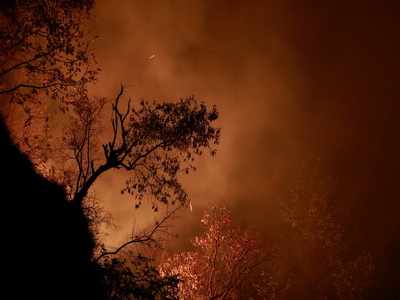- News
- India News
- Engineering students at Amrita Vishwa Vidyapeetham develop forest fire early detection system
Trending
This story is from April 13, 2021
Engineering students at Amrita Vishwa Vidyapeetham develop forest fire early detection system
A group of B.Tech students at Amrita Vishwa Vidyapeetham in Kerala have developed a ‘forest fire early detection system’, using UAV and advanced computation technology, to detect fires at an early stage and alert officials quickly by relaying the GPS location.

Representative image
NEW DELHI: A group of B.Tech students at Amrita Vishwa Vidyapeetham in Kerala have developed a ‘forest fire early detection system’, using UAV and advanced computation technology, to detect fires at an early stage and alert officials quickly by relaying the GPS location.
The system, funded by Kerala government’s forest & wildlife department, is successfully tested in Chambra Peak in Wayanad.Its prototype, costing around Rs 25,000, is currently being used in Wayanad district.
Unlike the satellite-based forest fire alerts system which is currently being used in many states across the country, the system developed by Amrita Vishwa Vidyapeetham can detect fires at an early stage and provide live streaming of the location to forest officials to avoid a false alarm. On the other hand, the existing detection system, using satellite imagery, takes landscape photos of the affected region and relays them to the forest officials after a gap of two days, making it difficult to stop the spread of the forest fires immediately.
The system - Known as ‘Agni Kavaj’ - developed by Amrita students at Amritapuri consists of a glider that carries two cameras, a video telemetry unit, GPS module, smoke sensor and microcontroller.
It said, “The second camera of the glider gives live streaming of the location to forest officials to avoid a false alarm.”
Every year large areas of forests are affected by fires of varying intensity and extent. As per forest inventory records, 54.40% of forests in India are exposed to occasional fires, 7.49% to moderately frequent fires and 2.40% to high incidence levels while 35.71% of India’s forests have not yet been exposed to fires of any real significance. In 2018, total 37,059 fires were detected using MODIS (Moderate Resolution Imaging Spectro-radiometer) sensor data.
The system, funded by Kerala government’s forest & wildlife department, is successfully tested in Chambra Peak in Wayanad.Its prototype, costing around Rs 25,000, is currently being used in Wayanad district.
Unlike the satellite-based forest fire alerts system which is currently being used in many states across the country, the system developed by Amrita Vishwa Vidyapeetham can detect fires at an early stage and provide live streaming of the location to forest officials to avoid a false alarm. On the other hand, the existing detection system, using satellite imagery, takes landscape photos of the affected region and relays them to the forest officials after a gap of two days, making it difficult to stop the spread of the forest fires immediately.
The system - Known as ‘Agni Kavaj’ - developed by Amrita students at Amritapuri consists of a glider that carries two cameras, a video telemetry unit, GPS module, smoke sensor and microcontroller.
“If normal fire image is detected, the communication part is made active and in a smoky environment, the sensor part of the glider is made active to check the amount of carbon dioxide present in the atmosphere. Readings in smoke sensors are monitored and if the reading is above a particular threshold level, then the communication part is made active which sends alert messages of the fire location to forest officials,” said a statement from the University.
It said, “The second camera of the glider gives live streaming of the location to forest officials to avoid a false alarm.”
Every year large areas of forests are affected by fires of varying intensity and extent. As per forest inventory records, 54.40% of forests in India are exposed to occasional fires, 7.49% to moderately frequent fires and 2.40% to high incidence levels while 35.71% of India’s forests have not yet been exposed to fires of any real significance. In 2018, total 37,059 fires were detected using MODIS (Moderate Resolution Imaging Spectro-radiometer) sensor data.
End of Article
FOLLOW US ON SOCIAL MEDIA











